Recently, I was
fortunate enough to find another very early Kine Exakta with even more
pre-production parts than the previous 2 early cameras I have
inspected.
The number of this latest Kine is 481750, which seems at first glance
to be much later than the previously listed 455681, but it appears
there is a cross-over of numbers in the very early Kines. There was
probably a very small batch of serial number plates made up with the
4556xx numbers and when the next batch of number plates was produced,
they were in the 4817xx range, most likely another very small batch.
The early and later number plates and camera parts were probably mixed
together in their bins and assembled at random in small batches as
required, creating an interesting mix of pre-production and later
production parts in these early models.
All the Ihagee cameras were sharing Ihageeís on-running numbering
system, so I assume numbers were allotted into batches for certain
models when required. It makes sense that only a small run of
"numbers" would be allotted for a new product until it was in full
production.
It appears that the 4556xx and 4817xx numbers were being assembled at
the same time in no particular order. It is also possible that many of
these cameras were slightly modified with later parts between the time
of first assembly and final shipping. Perhaps we will never know and
will always have to speculate, as I am doing here.
|
|
As more
of these early cameras appear we may be able to put more answers
together. I have just heard about another Kine, 455667, but apparently it has been
modernized in some ways. Iím waiting to see photos of it and will
report later. The only other early Kine serial numbers known are
455669 (seen in an early brochure) and 455664 (though hard to read)
that appears in the original Kine instruction book.
Of great interest is the mirror dating of the prewar
cameras. Few Exakta owners realize that on the back of the mirrors of
VP and Kine Exaktas is a date written in pencil (the mirror backs are
ground glass). I believe this date to be very close to the assembly
date of the camera, if not the exact date. You can read the date from
inside the back of the camera by lifting the two tabs holding the
mirror in place and sliding it down a few millimeters and opening the
shutter. The date is almost always written along the bottom edge of
the back of the mirror and this leads me to believe it was meant to be
easily read in this way.
Other cameras with mirror dates were prewar Rollieflex cameras. One
Rollie book claimed it had something to do with knowing when the
mirrors came to the factory from the mirror supplier so they would not
be kept in storage too long, but to my knowledge there is no proof of
this. Anyone out there know about this?
All 3 of the pre-production Kines have the same date behind the mirror
-- itís June 24 1936.
|
|
This is probably a
pretty accurate date of manufacture. These mirror dates bring into
question Richard Hummelís dating of the Kine Exaktas and when Ihagee changed from round to
rectangle magnifiers. In his book, Hummel claims that the change took
place in December 1936, but I have seen 3 mirrors from round magnifier
Kines that are from 1937, one from March and two from April. So it
appears that the change took place much later than Hummel suggests. I
felt it important to mention this as it does alter the Kine production
history somewhat.
My latest find is probably the most complete, untouched early Kine,
meaning that no one appears to have "changed parts" on it over the
years. Finding this 481750 camera means that the pre-production camera
mentioned in my previous article as being used as a parts camera can
be reunited with its original serial number 481744, which up until
recently was in a later style "restored Kine". We have discovered that
the 481744 camera and the pre-production "parts" camera came from the
same now-deceased owner who must have changed the serial number and
round magnifier plates around to a cleaner but later version of the
Kine. At least the 2 cameras are now in the same collection and have
been put right again!
|
|
The following
photos are of different pre-production parts on camera #481750, as
compared to later production cameras.
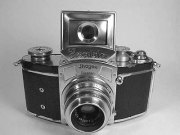
Photo one: Overall view of #481750
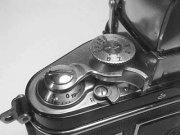
Photo two: frame counter starts at 0, not 1; "dot" after 1000th second
setting; no slotting in center of rewind switch lever; no cut-out in
metal next to the "R"
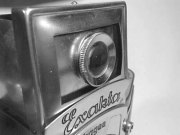
Photo three: raised bezel ring for round magnifier with knurled rim
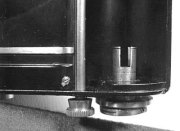
Photo four: Rewind fork is straight cut; film cutting knife is fine
knurled
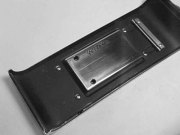
Photo five: no twin spring "fingers" for holding cassette in place
inside back; roller mount slightly different in size.
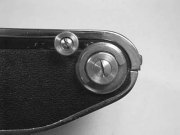
Photo six: wind and rewind lever handles smaller
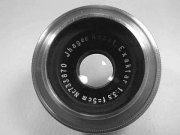
Photo seven: lens that came on this camera is an early Exaktar
engraved 5cm instead of 5.4cm like later versions.
This leads to the question of if there was a 5cm 1.9 Primoplan
like in some early promotional material. I think there was. One other
interesting difference not seen in the other pre-production or
production Kines is a completely different rewind mechanism. The
difference is in the gearing and can only be seen by partial
disassembly. I hope this article will inspire further research and
more theories about these important very early 35mm SLRís. |
|